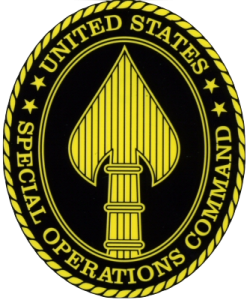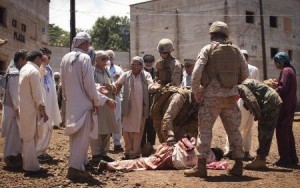Autumn. Low tide. A group of people wading in shallow water in a row dangling line over the water. Must be oama (baby goatfish) season, right?
Wrong. These guys are not fishing for oama. These men are workers from the state of Hawaii Department of Health absurdly conducting a radiation screening of Ahu o Laka (Kane’ohe Bay sandbar) with radiation monitors hanging over the surface of the water. The state admits that its radiation monitors are not the right tool for surveying underwater contamination.
Photo: Carroll Cox/ carrollcox.comWhy are they screening for radiation at the popular recreational site?
In March, a Marine Corps helicopter crashed on the sandbar, killing one crew and injuring several others. What the Marines never reported was that the helicopter components included a radioactive isotope Strontium-90, the same bone-attacking radiological substance spewed over the Pacific by the meltdown at the Fukushima nuclear power plant in Japan. You see, Strontium-90 is chemically related to Calcium, which it mimics when ingested into the body. Once inside bone tissue, the nasty little particles of radiation emitted from the decay of the isotope can wreak havoc on tissue, cells, and genes in very close proximity over a sustained period of time.
When another CH-53D Sea Stallion helicopter crashed into a university in Okinawa in 2004, Okinawan public safety crews and media and residents were forcefully excluded from the vicinity of the crash. Many were concerned that Depleted Uranium often used as counterweights on the rotors were a public health hazard. However, it appears that depleted uranium is used in the CH-46 Sea Knight helicopter, but only Strontium 90 is used in the CH-53 Sea Stallion.
Environmental investigator and activist Carroll Cox received a tip that radioactive substances were released by the crash and that rescue and salvage workers and public users of the bay may have been exposed to the hazardous material without their knowledge. He notified state officials, who were unaware of the public health hazard, as well as the media. Media reports on the radiation contamination can be read here, here, here and here.
Carroll writes on his blog:
Sources alerted The Carroll Cox Show, that civilian employees within the United States Marine Corps Environmental Department knowingly and intentionally withheld critical information about the presence of the radioactive isotope from the state, the workers at the crash site, and the public. Their actions caused the possible exposure of an untold number of people to radiation as they retrieved parts, looked for clues to the crash, contained leaking fuel, removed the aircraft from the site and assessed environmental impact, because they were working without protective gear.
The civilian support staff made the decision to not tell the workers even though the marine squadron that assigned the helicopter advised them that the aircraft contained IBIS units and they should treat the site as a hazardous waste spill.
Cox sent a series of questions to the Marine Corps and received a canned response. Here’s the correspondence between Cox and Marine Corps Public Affairs Officer Major Crouch:
Questions we asked the Marine Corps:
Did the aircraft contain radioactive materials as part of its cargo? If yes, what was the material and the quantity?
Did the aircraft’s rotors contain deicers or a safety In-flight Blade Inspection System (IBIS)? If yes, how many were there? Were all of the IBIS’s recovered? If yes, when were they recovered?
Were any of the radiated materials recovered and placed in a survival raft at the crash site? Were geiger counters used to recover the IBIS’s? Where were the IBIS’s stored once they were removed from the crash site?
How much strontium-90 is contained in each IBIS unit? Were any of the IBIS units damaged? If yes, what degree of damage was noted? Did any of the strontium -90 get released into the environment? if yes, how much?
Did your agency inform the public, first responders and all recovery personnel that the downed aircraft contained IBIS with strontium-90? If yes when and how was this accomplished? If not, why?
Why did your agency representative, Mr. Randall Hu, not disclose that the IBIS units contained strontium-90 during his appearances on television and other news accounts, and only expressed concerns about the fuel that the craft contained?
Did the location and recovery of the IBIS units cause the Marines to delay the removal of the downed aircraft?
In several news accounts it was reported that “the Marines were to comb the bay looking for any metal scraps and inspect the area for any environmental damage”. Were these Marines wearing the proper safety gear to search and retrieve strontium-90, the IBIS units or other radioactive materials?
What was the final disposition of the IBIS’s or strontium-90?
Is it the opinion of the United States Marine Corps that the presence of strontium-90 aboard aircrafts that have crashed are not an environmental hazard requiring public reporting? If no, why not?
Did your agency meet with management of the Honolulu Fire Department to discuss the failure of your agency to notify them of the presence of strontium-90 aboard the downed aircraft? If yes, please provide a copy of their concerns and the Marine Corps’ response?
Were members of the recovery teams screened for exposure to strontium-90? If yes, when and by whom? If no, why not?
Is the Marine Corps conducting any type of monitoring for the presence of strontium-90 at and around the crash site? If yes, what are the results? If no, why not?
Did The Marine Corps notify the Hawaii State Department of Conservation or other agencies that the downed aircraft was equipped with IBIS’s or other parts containing strontium-90?
If yes, when and how were the each of the agencies notified? Please provide copies of the notification.
———————————————————————————————————————
The answer we received from Major Crouch:
Subject: CARROLL COX SHOW – QUERY RE: CH-53D MISHAP
From: “Crouch Maj Alan F” <alan.crouch@usmc.mil>
Date: Thu, September 01, 2011 4:34 pm
Aloha Mr. Cox, Marine Corps Base Hawaii takes its obligation to protect personnel, the public and the ‘āina very seriously. Our first responsibility after the tragic mishap on March 29 was the rescue of personnel in the downed helicopter. Rescue responders included the Marine Corps Base Hawaii Waterfront Operations, aircraft from the U.S. Coast Guard and Army and the Honolulu Fire Department, as well as another CH-53D from MCAS Kaneohe Bay.
Almost immediately, base personnel placed a floating containment boom around the site to prevent the spread of petroleum fluids. Shortly thereafter, base and squadron personnel, with assistance from Navy, Coast Guard and state personnel, began the process of recovering the remains of the helicopter while an aviation mishap board conducted its investigation.
During the recovery efforts, some aircraft components were found to have a low level of contamination. All materials found to be contaminated were decontaminated or appropriately contained here on base. All personnel involved in the handling of any contaminated material were screened to verify they were not contaminated.
The low levels of radiation previously detected pose no significant health or environmental risk and were not of a reportable quantity. The site on the sand bar where the helicopter rested was inspected both during and after the salvage and recovery of the aircraft as a precautionary measure. No radiological contamination was found at the site.
Regards,
Maj. Alan Crouch Director,
Public Affairs Office
Marine Corps Base Hawaii
(808) 257-8840/-8870
In other words, the Marine Corps dodged nearly all the questions.
But it gets even worse. The Marines lost the raft containing the radioactive parts. The raft drifted around Kane’ohe Bay for some time before it was found by residents near the bay:
On Sunday, September 4, after our broadcast we learned the raft used to hold and transport the IBIS units and radioactive waste came lose from its mooring at the crash site, floated around Kaneohe Bay, and ended up by Kamehameha Hwy. A number of citizens came in contact with the raft.
Here are the questions Mr. Cox sent to the Marine Corps about the lost raft:
September 5, 2011
Major Alan Crouch
United States Marine Corps
Dear Major Crouch;
It has been brought to our attention that the life raft used at the site of the US. Marine Corps CH53 helicopter crash on March 29, 2011, broke loose from its mooring and drifted from the crash site to a residential area along Kamehameha Hwy at Kaneohe Bay. It is our understanding that the U.S. Marine Corps used the raft to store and transport radioactive materials containing Strontium-90 from the helicopter. We also learned, and as you have confirmed, the raft containing the radioactive material was transported to the water ops pier at the Kanoehe Bay Marine Corps Base and stored for a period of time. Reportedly it leaked radioactive materials onto the pavement of the pier area, causing some 65 square feet of cement to be excavated. We would like to ask you the following questions regarding the raft:
1. What date did the raft become dislodged from the crash site and the Marines lose custody of the raft?
2. How many days was the raft adrift?
3. How did the marines learn the raft was missing?
4. Did any of the civilians who had the raft in their possession during the time it was adrift remove any of the materials contaminated with radiation or the IBIS components?
5. Did you screen the individuals for radiation contamination? If yes, what were the results?
6. Did the Marine Corps screen the area along Kamehameha Hwy where the raft was recovered from? If yes, what was the level?
7. We have a picture showing a civilian towing the raft by boat. Did you screen that individual for radiation contamination?
8. After the marines retrieved the raft from the civilian did the marines immediately take it the water ops area on the base?
9. Did you notify the surrounding community and the individuals that came in contact with the raft that it contained radioactive Strontium-90?
10. Will there be charges brought against any of the civilians for handling the raft and materials?
11. Did the Marine Corps notify the U.S. Coast Guard, the Dept. of Health, DLNR, or other agencies that the raft was missing for several days? If so, when and to whom was notification made?
I would appreciate it if you would please provide answers to my questions by Thursday, September 8.
Sincerely,
Carroll Cox
He has not yet received an answer. READ THE FULL ACCOUNT ON CARROLLCOX.COM.
Photo: Carroll Cox / carrollcox.com
In the photo above of the downed helicopter, you can see the orange life raft that was used to contain the radioactive IBIS parts. This raft broke loose some time after this and drifted across Kane’ohe Bay, eventually reaching residential areas along the bay shore.
A contact who lives on the shores of Kane’ohe Bay in Kahalu’u saw the raft adrift while working on a canoe.
This incident underscores the hazards of such intensive military activity in Hawai’i, the inability of the military to manage the risks and the secrecy and lack of honesty of the military when dealing with the public. To paraphrase our friends in Vieques, Puerto Rico, history does not permit us to trust what the military says.
This incident also highlights why we must stop the proposed expansion of helicopter and Osprey facilities and activities at Mokapu (Kane’ohe Marine base).





